Palm - Mexican Fan
Abundance: uncommon
What: fruit
How: raw, dried
Where: landscaping, wild along Gulf Coast.
When:
Nutritional Value:
Dangers:
Fan-shaped fronds have spiny stalks. Fruit is blue-black, pea-sized, sweet with a large, inedible seed.
Buy my book! Outdoor Adventure Guides Foraging covers 70 of North America's tastiest and easy to find wild edibles shown with the same big pictures as here on the Foraging Texas website.
Palm - Texas Sabal
Abundance: common
What: fruit, palm heart
How: fruit raw; palm heart roasted, pickled
Where: landscaping, wild from southern to central Texas
When: summer, fall, spring
Nutritional Value:
Dangers: none
Texas sabal palm.


Texas sabal palm base.

Texas sabal palm trunk and crown.

Texas sabal palm fan-type leaves.

Fruit dark purple, .5” in diameter, thinly fleshed over a large seed, ripens in summer.
The palm heart is also eaten, but harvesting it kills the palm. Palm hearts (terminal buds) are the "root" the center-most, youngest leaf at the very top of the tree. It is harvested by cutting off the top of the tree and carving out the palm heart which kills the tree.
Leaf fibers make great cordage.
Buy my book! Outdoor Adventure Guides Foraging covers 70 of North America's tastiest and easy to find wild edibles shown with the same big pictures as here on the Foraging Texas website.
Palm - Windmill
Abundance: common
What: flower buds and flowers (inflorescences)
How: raw or cooked
Where: landscaping
When: spring
Nutritional Value:
Dangers:
Windmill palm.

Windmill palm base.

Windmill palm trunk.

Windmill palm fan-type leaf.

Native to China, this palm actually prefers cold climates and doesn't do well in hot, humid areas such as the Gulf Coast region. The leaf fibers make an excellent cordage.
The flower buds and flower bodies are eaten raw though I bet they could be candied, too.
Fruit ranges in color from yellow to black.
Buy my book! Outdoor Adventure Guides Foraging covers 70 of North America's tastiest and easy to find wild edibles shown with the same big pictures as here on the Foraging Texas website.
Peppervine
Abundance: common
What: ripe berries (black)
How: cooked, wine
Where: woods, borders
When: late summer, fall
Nutritional Value: low in carbohydrates, minerals and vitamins
Dangers: Berries contain crystals of calcium oxalate which must be removed before consuming.




Texas distribution, attributed to U. S. Department of Agriculture. The marked counties are guidelines only. Plants may appear in other counties, especially if used in landscaping.

North American distribution, attributed to U. S. Department of Agriculture.

Peppervine is a summertime vine that loves hot weather though the berries don't appear until close to the start of the school year. These vines prefer full sun to partial shade so look for them along fences in your neighborhood and climbing over bushes at the edges of woods. Soil type doesn't seem to matter.
The sweet, grape-flavored berries are ripe when they are black. Leave the spotted pink and purple berries to ripen more. Though delicious, most people get a weird tickle in the back of their throat after eating one or more berries. This tickle is actually due to tiny needles of calcium oxalate which are defensive measure of the Peppervine. Excessive consumption of calcium oxalate will result in chemical burns in your throat.
Luckily, calcium oxalate isn't very water soluble and easy to separate from the berries' juice. My preferred method is to squeeze the berries through cheesecloth, collecting the juice and discarding any solids left in the cheesecloth. Now add one ounce of tap water to every nine ounces of juice and place this solution in a see-through pitcher or bottle in your refrigerator. Let it sit overnight which causes the needles of calcium oxalate to settle down to the bottom of the container. Carefully pour off the liquid while avoiding stirring up and re-adding the calcium oxalate back into the solution. Pouring it through a coffee filter will help remove the crystals. It's best to err on the side of caution and leave behind juice rather than get some of the calcium oxalate.
Once you've operated out the calcium oxalate you can use this juice like grape juice. Drink it, jelly/jam it, or even make wine from it!
Persimmon - Texas
Abundance: plentiful
What: fruit
How: raw, jams, jelly, candied, tarts
Where: fields, sunny edges of woods, arid areas
When: late summer, fall
Nutritional Value: fiber, Vit C, B, minerals, anti-oxidants, flavonoids.
Texas persimmon fruit, both ripe (black) and unripe (green).

Close-ups of Texas persimmon fruit.


Texas persimmon seeds.

Texas persimmon seeds in animal scats (probably raccoon).


Texas persimmon shrub/tree.

Close-up of Texas persimmon leaves.

Texas persimmon trunk, next to an oak tree which shades it.

Texas distribution, attributed to U. S. Department of Agriculture. The marked counties are guidelines only. Plants may appear in other counties, especially if used in landscaping.
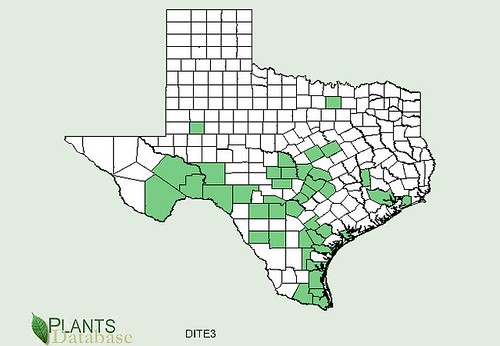
North American distribution, attributed to U. S. Department of Agriculture.

The Texas Persimmon tree is mainly found in Central and Southern Texas. Once can not walk far in the Texas Hill Country without coming across the gnarled, grey shrub with grey, peeling bark. I personally love the looks of the Texas persimmon. It is generally very short, rarely over eight feet tall. They prefer to grow in partially shaded areas, such as under an oak. Most herbivore and omnivore wild animals love the ripe persimmons and I often am alerted to the trees' presence in a near area by first seeing pig scat loaded with persimmon seeds.
Persimmons aren't sweet enough to eat until they are very dark purple-black in color and already falling off the tree. The seeds are very easy to sprout, resulting in numerous persimmon trees in the same area. Like the Virginian persimmon, Texas persimmons are not self-fertile and require both male and female trees to be present for the female tree to produce fruit.
Virginian Persimmons have both male and female trees and both need to be present for fruit. Only the females produce fruit but male trees must be present to fertilize her flowers.
Buy my book! Outdoor Adventure Guides Foraging covers 70 of North America's tastiest and easy to find wild edibles shown with the same big pictures as here on the Foraging Texas website.
Persimmon - Virginian
Abundance: plentiful
What: fruit, leaves
How: fruit - raw, jams, jelly, candied, tarts; leaves - tea
Where: fields, sunny edges of woods
When: late summer, fall
Nutritional Value: fiber, Vit C, B, minerals, anti-oxidants, flavonoids.

Virginia persimmon fruit is best/sweetest when it is orange in color and the "crown" separates easily from the fruit. In general, only female persimmon trees produce fruit but there are rare occasion when male trees have suddenly produced a few fruit now and then.
Unripe persimmon.

Young persimmon tree. Mature trees can grow 40 to 60 feet tall. The bark is gray to black in color.

Persimmon leaves are oval, smooth-edged, dark green on top and light green/gray on the bottom.
Unripe fruit. Persimmons contain six flatish seeds.

Virginia persimmon in the fall after losing its leaves but still retaining fruit.
Ripe fruit. Note the "crown" where it was attached to the tree.
If the crown separates easily from the fruit it's ready to eat. No frost needed!
Scaly/craggy bark of a mature Virginia persimmon tree.
Raccoons, coyotes, possums, and wild hogs love ripe Virginia persimmons. Finding the seeds in animal poop is a good indication to check your fruit for ripeness. These seeds are approximately 1/2" long.
Texas distribution, attributed to U. S. Department of Agriculture. The marked counties are guidelines only. Plants may appear in other counties, especially if used in landscaping.

North American distribution, attributed to U. S. Department of Agriculture.
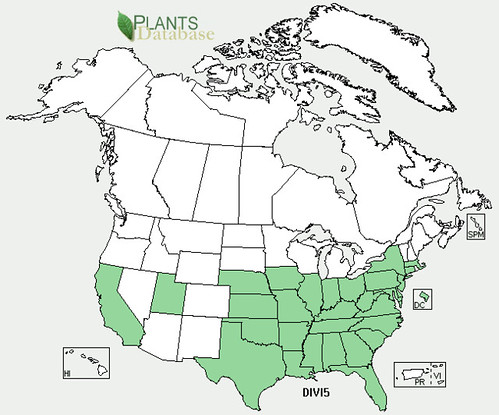
The Virginian Persimmon tree is mainly found in the northern areas of East Texas. The trees usually appear together in great numbers due to the many animals that eat the fruit and spread the seeds...along with a nice dollop of fertilizer. The trees are deciduous, losing their leaves in the fall. Only the females produce the edible fruit and the natural ratio for these trees is one female for every ten males. This means you need to plant a lot of seedlings to insure fruit. No one has yet figured out how to tell if a persimmon tree is male or female until it's started producing flowers...about seven years old. Luckily the seeds are very easy to sprout, resulting in numerous persimmon trees in the same area. Persimmon wood is very dense and hard, much like its relative ebony. It's a bit heavy as a walking stick but dang near indestructible so that's what I use.
Persimmons aren't sweet enough to eat until they are dark orange in color and their crown is easily plucked from the fruit. An unripe persimmon is extremely astringent and will suck all the moisture from your mouth...which is kind of a funny joke to do to someone.
The ripe fruit has a wonderful, sweet flavor. The skins are edible but the body has a hard time digesting them. This can lead to an obstructed bowel if too many fruit are eaten at once.
Buy my book! Outdoor Adventure Guides Foraging covers 70 of North America's tastiest and easy to find wild edibles shown with the same big pictures as here on the Foraging Texas website.
Pokeweed/Poke Salat
Abundance: uncommon
What: young shoots & leaves, berry juice
How: young shoots & leaves boiled in three changes of water; berry juice boiled then made into jam/jelly
Where: woods, shady areas, sunny areas, fields
When: spring
Nutritional Value: vitamins
Dangers: all parts of plant contain different amounts of extremely toxic (fatal) alkaloid compounds, especially roots, stems, mature leaves, and seeds.
Medicinal Summary:
Root* - lymph flow stimulator; anti-inflammatory; anti-swelling; antibacterial (tincture)
*extremely poisonous, only to be used by trained experts!
Young pokeweed plants, ready to be boiled then eaten.

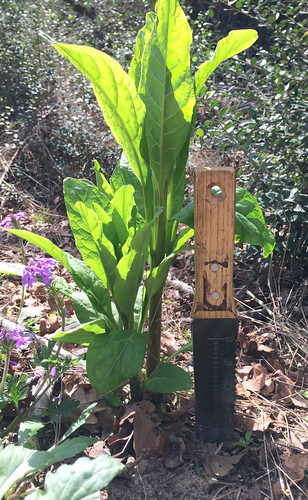

Young sprouts next to a more mature pokeweed. Red color has already appeared in the older pokeweed's stem, indicating it is now unsafe to eat, even after multiple boilings.

Mature plants can grow to over 5' tall in one summer, making them one of the fastest growing plants in Texas. When mature they'll have red stalks, and multiple berry clusters as shown below.

Close-up of a flower spike. The flowers spiral up the spike. The round bulbs haven't blossomed yet.
Extreme close-up of a single pokeweed flower. Note the five, white petals.
After the flower are done the berries begin to grow. They remind me of squat, green pumpkins at first.
The older berries, near the base of the spike, ripen to a purple color before the berries at the tip. The seeds are extremely poisonous but the pokeweed berry juice can be made into a jelly...very carefully!
Completely ripe, now. They form a single spiral down the stalk, just like the flowers did.
Texas distribution, attributed to U. S. Department of Agriculture. The marked counties are guidelines only. Plants may appear in other counties, especially if used in landscaping.
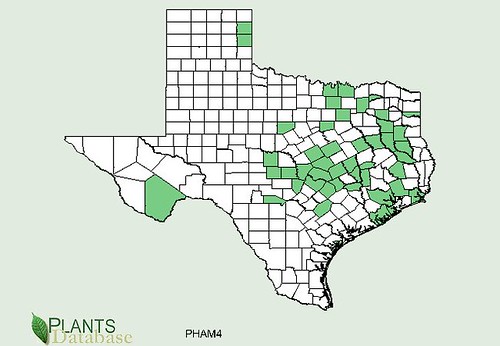
North American distribution, attributed to U. S. Department of Agriculture.
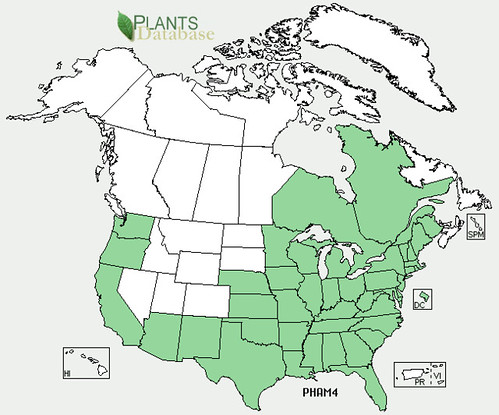
Pokeweed was often one of the first greens to appear after a winter devoid of fresh plants and so it was cherished not just for its fantastic taste but also because it allowed satisfying a hunger for plants. It mainly grows in the protective yet sunny edges of woods with braver plants being out in full sun an others hiding in complete shade. It's bright green color stands out among the darker greens, browns, and grays of later winter plants. The stem starts out green like the leaves but quickly turns red as it matures. The youngest part of the stem at the top of the plant may stay green while the rest of the stem turns almost a purple-red color.
Young, boiled pokeweed leaves & shoots are considered a special treat in the South and a canned version is occasionally available in grocery stores. The pokeweed leaves must be harvested before there is any noticeable red color in the leaves or stem, usually when the plant is still under about six inches tall. Even at this young age there are highly toxic alkaloids present so the leaves must be boiled in three changes of water to render them safe enough to eat. Bring just to a boil, then replace the hot water with fresh, room temperature water. Unfortunately, the required boiling does reduce their vitamin C content some but they will remain loaded with all sorts of other vitamins and minerals.
The seeds are very toxic even after cooking, but the juice of the berries can be made safe by boiling. After boiling the berry juice can be made into a jam or jelly. The berry juice can also be used as a dye or even as an ink.
Buy my book! Outdoor Adventure Guides Foraging covers 70 of North America's tastiest and easy to find wild edibles shown with the same big pictures as here on the Foraging Texas website.
Privacy & Amazon Paid Promotion Statement
I use third-party advertising companies to serve ads when you visit this website. These companies may use information (not including your name, address, email address, or telephone number) about your visits to this and other websites in order to provide advertisements about goods and services of interest to you. If you would like more information about this practice and to know your choices about not having this information used by these companies, click here.
I participate in the Amazon Services LLC Associates Program, an affiliate advertising program designed to provide a means for me to earn fees by linking to Amazon.com and affiliated sites. The prices you pay for the item isn't affected, my sales commission comes out of Amazon's pocket.
*These statements have not been evaluated by the Food and Drug Administration. This product is not intended to diagnose, treat, cure, or prevent any disease.

















